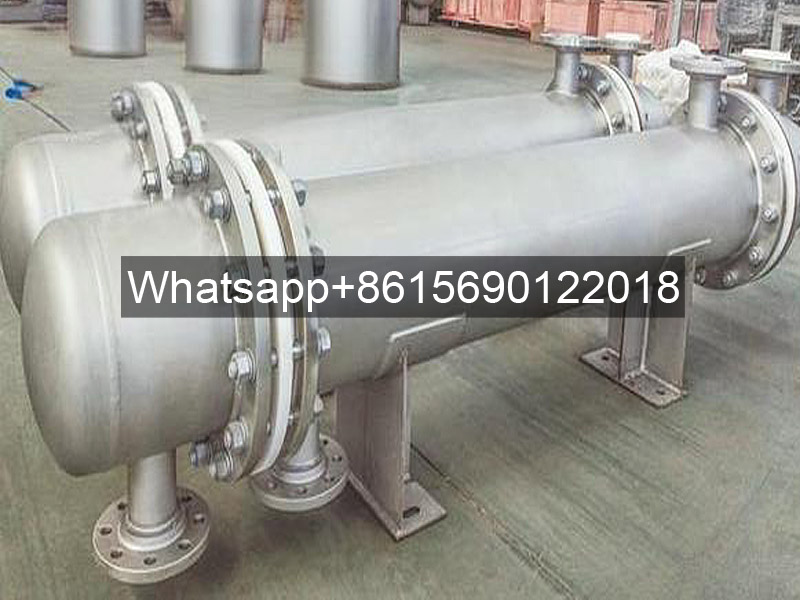Condenser
The condenser is a component of the refrigeration system and a type of heat exchanger. It can convert gas or steam into liquid and transfer the heat in the tube to the air near the tube in a very fast manner. The working process of the condenser is an exothermic process, so the condenser temperature is relatively high.
Power plants use many condensers to condense the steam discharged from the turbine. In refrigeration plants, condensers are used to condense refrigerant vapors such as ammonia and Freon. In the petrochemical industry, condensers are used to condense hydrocarbons and other chemical vapors. In the distillation process, the device that converts steam into liquid is also called a condenser. All condensers operate by removing heat from gas or steam.

Condenser by Material
Principle of condenser
The gas passes through a long tube (usually coiled into a solenoid) to dissipate heat into the surrounding air. Metals such as copper have strong thermal conductivity and are often used to transport steam. In order to improve the efficiency of the condenser, heat sinks with excellent thermal conductivity are often attached to the pipes to increase the heat dissipation area to accelerate heat dissipation, and fans are used to accelerate air convection to remove heat.
In the circulation system of the refrigerator, the compressor inhales low-temperature and low-pressure refrigerant vapor from the evaporator, which is adiabatically compressed by the compressor to become high-temperature and high-pressure superheated steam, and then pressed into the condenser for constant pressure cooling, releasing heat to the cooling medium, and then cooled into supercooled liquid refrigerant. The liquid refrigerant is adiabatically throttled by the expansion valve to become a low-pressure liquid refrigerant, which evaporates in the evaporator to absorb the heat in the air-conditioning circulating water (air), thereby cooling the air-conditioning circulating water to achieve the purpose of refrigeration, and the low-pressure refrigerant flowing out is sucked into the compressor, and the cycle works in this way.
The single-stage vapor compression refrigeration system consists of four basic components: refrigeration compressor, condenser, throttle valve and evaporator. They are connected in sequence by pipes to form a closed system. The refrigerant circulates continuously in the system, changes state, and exchanges heat with the outside world.
Types of condensers
Steam condenser
This type of condensation is often used for the condensation of secondary steam in the last effect of the multi-effect evaporator to ensure the vacuum degree of the last effect evaporator.
Example (1) Spray condenser, cold water is sprayed from the upper nozzle, steam enters from the side inlet, steam is condensed into water after full contact with cold water, and flows down the tube at the same time, and some non-condensable gas may also be taken out.
Example (2) Filling condenser, steam enters from the side tube and contacts with cold water sprayed from above. The condenser is filled with ceramic ring packing. After the packing is wetted by water, the contact area between cold water and steam is increased. After the steam condenses into water, it flows out along the lower pipeline. The non-condensable gas is pumped out by the vacuum pump along the upper pipeline to ensure a certain vacuum degree in the condenser.
Example (3) Spray plate or sieve plate condenser, the purpose is to increase the contact area between cold water and steam. The hybrid condenser has the advantages of simple structure and high heat transfer efficiency, and the corrosion problem is also relatively easy to solve.
Boiler condenser
Boiler condenser, also known as flue gas condenser, can effectively save production costs, reduce boiler exhaust temperature, and improve boiler thermal efficiency after using flue gas condenser.
In traditional boilers, after the fuel is burned in the boiler, the exhaust gas temperature is relatively high, and the water vapor in the flue gas is still in a gaseous state, which will take away a lot of heat. Among all kinds of fossil fuels, natural gas has the highest hydrogen content, with a mass percentage of hydrogen of about 20% to 25%. Therefore, the exhaust gas contains a large amount of water vapor. According to calculations, the heat paper to be taken away by the steam generated by burning 1 square meter of natural gas is 4000KJ, which is about more than 10% of its high calorific value.
The flue gas condensation waste heat recovery device uses low-temperature water or air to cool the flue gas to reduce the flue gas temperature. Near the heat exchange surface area, the water vapor in the flue gas condenses, and at the same time, the sensible heat release of the flue gas and the latent heat release of the water vapor condensation are realized. The water or air in the heat exchanger absorbs heat and is heated, realizing heat recovery and improving the thermal


